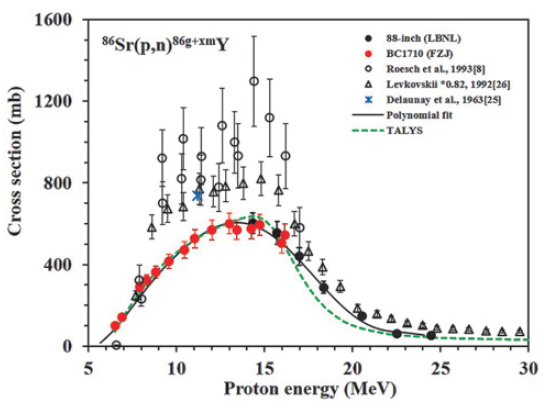86Y Collaboration
The positron-emitting radionuclide 86Y (T1/2 = 14.7 h) has been gaining increasing importance due to its theranostic application, i.e. its diagnostic use prior to the medication with the β--emitting therapeutic radionuclide 90Y (T1/2 = 2.7 d). This concept was first applied at the Forschungszentrum Julich (FZJ), Germany, in the context of treatment of a patient with disseminated bone metastases by using the therapeutic radionuclide 90Y. A positron emission tomographic (PET) measurement of the injected 86Y-citrate prior to therapy gave the distribution of the radioactivity in various organs, wherefrom the radiation dose caused by the subsequently administered therapeutic-agent 90Y-citrate was quantitatively calculated [1].
There are significant discrepancies exist in the literature for the excitation function of the 86Sr(p,n)86g+xmY reaction which is the method of choice for the production of the non-standard positron emitter 86Y for theranostic application. Several measurements for determining the cross sections of this reaction were carried out from its threshold up to 16.2 MeV at FZJ, Germany and from 14.3 to 24.5 MeV at LBNL, USA. Thin samples of 96.4 % enriched 86SrCO3 were prepared by sedimentation and after irradiation with protons in a stacked-form, the induced radioactivity was measured by high-resolution γ-ray spectrometry. The projectile flux was determined by using the monitor reactions natCu(p,xn)62,63,65Zn and natTi(p,x)48V, and the calculated proton energy for each sample was verified by considering the ratios of two reaction products of different thresholds. The experimental cross section data obtained agreed well with the results of a nuclear model calculation based on the code TALYS. From the cross section data, the integral yield of 86Y was calculated. Over the optimum production energy range Ep = 7-14 MeV the yield of 86Y amounts to 291 MBq/μA for 1 h irradiation time. This value is appreciably lower than the previous literature values calculated from measured and evaluated excitation functions. It is, however, more compatible with the experimental yields of 86Y obtained in clinical scale production runs. The levels of the isotopic impurities 87mY, 87gY and 88Y were also estimated and found to be < 2 % in sum. Recently, a manuscript has been submitted to the Radiochemica Acta journal for publication.

Fig. Excitation function of 86Y production in proton irradiation of an enriched 86Sr target.
1. Herzog, H., Rösch, F., Stöcklin, G., Lueders, C., Qaim, S.M., Feinendegen, L.E.: Measurement of pharmacokinetics of 86Y radiopharmaceuticals with PET and radiation dose calculation of analogous 90Y radiotherapeutics. J. Nucl. Med. 34, 2222-2226 (1993).